#February 1971
Explore tagged Tumblr posts
Text

Horror Stories, magazine, Stanley Pub., February 1971
#witches#story tellers#occult#vintage#horror stories#horror#magazine#stories#stanley publications#february 1971#1971#howling men#vampires#zombies#satan slaves
11 notes
·
View notes
Text

Vogue Italia February 1971
Willy van Roy and Wallis Franken in typically 1940s dresses, knee-length, in crepe, with high shoulders, gathered necklines, futuristic prints. “Coupole” makeup exclusively for Vogue, by Gil from Max Factor. 40s hairstyles by Jean-Mare Maniatis. All accessories: Saint Laurent Rive Gauche.
Willy van Roy et Wallis Franken dans des robes typiquement années 40, jusqu'aux genoux, en crêpe, avec des épaules hautes, décolletés froncés, des imprimés futuristes. Maquillage "Coupole" en exclusivité pour Vogue, par Gil de Max Factor. Coiffures années 40 par Jean-Mare Maniatis. Tous les accessoires : Saint Laurent Rive Gauche.
Photo Chris von Wangenheim Vogue Italia Archivio
#ready to wear#prêt à porter#yves saint laurent rive gauche#ysl#fashion 70s#1971#spring/summer#printemps/été#willy vanroy#wallis franken#chris von wangenheim#vintage fashion#vogue italia#february 1971#jean-marc maniatis#max factor
10 notes
·
View notes
Text

"An excellent view of the Apollo 14 Lunar Module (LM-8) Antares on the moon, as photographed during the first Apollo 14 extravehicular activity (EVA) on the lunar surface. While astronauts Alan B. Shepard Jr., commander, and Edgar D. Mitchell, lunar module pilot, descended in the LM to explore the moon, astronaut Stuart A. Roosa, command module pilot, remained with the Command and Service Modules (CSM) in lunar orbit."
Date: February 5, 1971
NASA ID: AS14-66-9278
61 notes
·
View notes
Text
February 8, 1971

[Liverpool Echo, February 8, 1971]
On this date in 1971, Paul was kicked out of 21 twice for wearing sneakers and refusing to wear a tie, a fact he attempted to hide on his second go by wearing an overcoat and claiming he was too cold to take it off.
122 notes
·
View notes
Text

Tasha & Sidra Smith: February 28, 1971
#Happy Birthday Tasha & Sidra Smith#Happy Birthday#Birthday Photosets#Nesha Photosets#Pink Aesthetic#February Birthdays#celebrity birthdays#birthdays#February#Tasha & Sidra Smith#Tasha Smith#Sidra Smith#Black Twins#sisters#Happy Birthday Tasha and Sidra#February 28#1971#twins#twin sisters#Black Women in Entertainment#Flooding Your Dash with Black Lady Face#Flooding Your Dash with Dark Skin Beauty
3 notes
·
View notes
Text










English musician and singer Paul McCartney of the Beatles and his wife Linda (1941 - 1998) outside the Royal Courts of Justice in London, UK, 19th February 1971. McCartney is bringing a lawsuit against his former bandmates, to dissolve the Beatles' partnership🌼
Credit: (Photo by Jones/Daily Express/Getty Images)/ gettyimages®/ pinterest.com/ instagram.com🌼
#60s icons#girlsofthesixties#60s couples#the beatles wives#paul mccartney#linda mccartney#paul and linda#19th february 1971#instagram#pinterest#getty images
6 notes
·
View notes
Text
Nirvana - The Man Who Sold the World 1993
"The Man Who Sold the World" is the title track of David Bowie's third studio album, which was released in 1970 in the US and in 1971 in the UK. Although no singles were issued from the album, the song appeared as the B-side on the 1973 reissue US single release of "Space Oddity" and UK single release of "Life on Mars?".
In his journals, Kurt Cobain of the American grunge band Nirvana ranked the album The Man Who Sold the World at number 45 in his top 50 favourite albums. Nirvana subsequently recorded a live rendition of the song during their MTV Unplugged appearance at Sony Music Studios in New York City on 18 November 1993 and it was included on their MTV Unplugged in New York album released on November 1, 1994, nearly seven months following the death of Cobain. The song was also released as a promotional single for the album in 1995.
Nirvana's cover received considerable airplay on alternative rock radio stations and was also placed into heavy rotation on MTV, peaking at number 3 on MTV's most played videos on 18 February 1995; it also peaked for two weeks at number 7 on Canada's MuchMusic Countdown in March 1995. Nirvana regularly covered the song during live sets after their MTV Unplugged performance up until Cobain's death. In 2002, the song was re-released on Nirvana's self-titled "best of" compilation.
Bowie said of Nirvana's cover: "I was simply blown away when I found that Kurt Cobain liked my work, and have always wanted to talk to him about his reasons for covering 'The Man Who Sold the World'" and that "it was a good straight forward rendition and sounded somehow very honest." Bowie called Nirvana's cover "heartfelt", noting that "until this [cover], it hadn't occurred to me that I was part of America's musical landscape. I always felt my weight in Europe, but not [in the US]." In the wake of its release, Bowie bemoaned the fact that when he performed the number himself, he would encounter "kids that come up afterwards and say, 'It's cool you're doing a Nirvana song.' And I think, 'Fuck you, you little tosser!'"
At a pre–Grammy Awards party on 14 February 2016, Nirvana band members Krist Novoselic, Dave Grohl, and Pat Smear teamed up with Beck to perform "The Man Who Sold the World" in tribute to Bowie – who had died the month before — with Beck performing vocals.
"The Man Who Sold the World" received a total of 77,6% yes votes! Dave Grohl has previously been featured in the polls with Foo Fighter's "The Pretender" at #111 and as a drummer on Queens of the Stone Age's "No One Knows" at #87, and David Bowie has been featured with "I'm Afraid of Americans" at #33.
youtube
#finished#high votes#high yes#high reblog#90s#70s#nirvana#david bowie#dave grohl#english#o1#o1 sweep
1K notes
·
View notes
Text

On this day in 1992, Randy Weaver and his family were attacked by Federal law enforcement at their home on Ruby Ridge in Boundary County, Idaho. What began on that day would quickly become known as one of the most egregious examples of Federal police tyranny in the nation's history. 👇
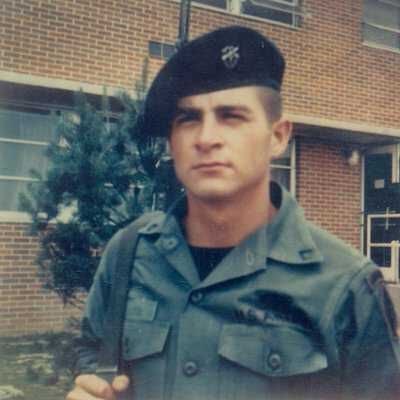
Randall Claude Weaver, who preferred to be called Pete as he hated his given name, was born in Villisca, Iowa to poor farming parents. One of four children, his family was extremely religious, though they often struggled to find a denomination that fit their beliefs. In 1968, Weaver dropped out of high school and enlisted in the US Military. 👇
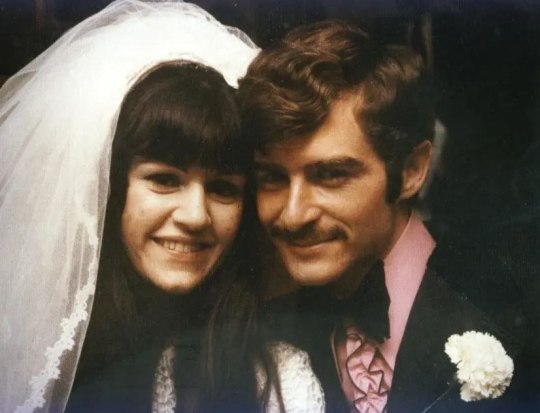
While home on leave, he met his future wife, Victoria "Vicki" Jordison. In 1971, Weaver left the Army at the rank of Sergeant and a month later, he and Vicki were married. Randy quickly enrolled in Community College with the goal of becoming an FBI agent, but the high cost of tuition prevented him from completing school. He found work at the local John Deere factory while his wife became a homemaker as they began having children. 👇
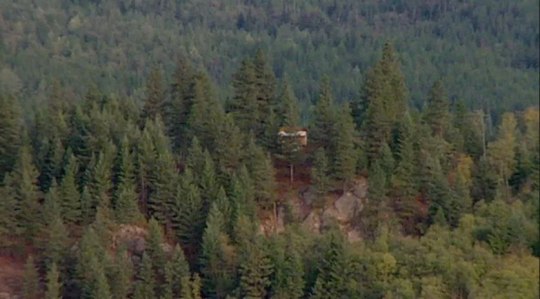
Over time, they began developing a deeper and deeper distrust of the government, and Vicki began having "visions" that the Apocalypse was coming. The family decided their only option was to move off the grid. They spent time among the Amish, learning how to live without electricity. Then they emptied their life savings of $5000 to buy the small mountain property in northern Idaho. 👇
In 1984, their troubles began. Randy had a falling out with neighbor Terry Kinnison, over a $3,000 land deal. Kinnison lost the ensuing lawsuit and was ordered to pay Weaver an additional $2,100 in court costs and damages. Kinnison took his vengeance in letters written to the FBI, Secret Service, and county sheriff, claiming that Weaver had threatened to kill Pope John Paul II, President Ronald Reagan, and Idaho governor John Evans. 👇
Randy and Vicki Weaver were interviewed by the FBI, Secret Service, and the County Sheriff. Police were told that Weaver was a member of the white supremacist Aryan Nation and that he had a large gun collection in his cabin. Weaver denied the allegations, and no charges were filed. 👇
The Weavers filed an affidavit in 1985, claiming their enemies were plotting to provoke the FBI into killing them. The couple wrote a letter to President Reagan, claiming a threatening letter may have been sent to him, over a forged signature. No such letter ever materialized but, seven years later, prosecutors would cite the 1985 note as evidence of a Weaver family conspiracy against the government. 👇
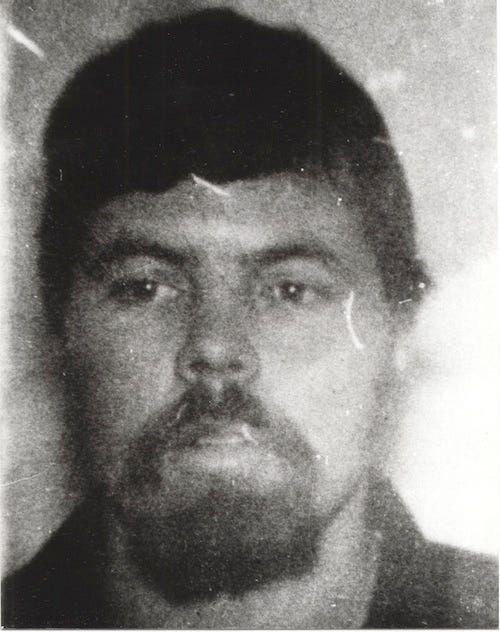
One of the Weaver's neighbors, Frank Kumnick, was a member of the Aryan Nation, and invited Randy to attend a World Aryan Congress in 1986. Unknown to either man was that Kumnick was already a target of the ATF. 👇
While at this "Congress", Weaver met a man posing as a gun dealer who was actually an undercover ATF agent. Randy invited this man to his home to discuss forming a resistance group against what they called the "Zionist Occupation Government". 👇
Later that same year, the ATF would charge Weaver with selling that informant two sawed-off shotguns. 👇
The ATF offered to drop all charges, as long as Randy was willing to become a confidential informant. Randy refused. The indictments came down shortly after, claiming that Randy was a "bank robber" with an extensive criminal history. These allegations were of course fabricated. However, Randy was still arrested and then released, pending trial. 👇
Trial was set for February 20, 1991 and subsequently moved to February 21, due to a federal holiday. Weaver’s parole officer sent him a letter, erroneously stating that the new date was March 20. A bench warrant was issued when Weaver failed to show in court, for the February date. Randy was, despite being completely unaware of it, officially labeled a fugitive from justice. 👇
The U.S. Marshals Service agreed to put off execution of the warrant until after the March 20 date, but the U.S. Attorney’s Office called a grand jury, a week earlier. It’s been said that a grand jury could indict a ham sandwich and the adage proved true, particularly when the prosecution failed to reveal parole officer Richins’ letter, with the March 20 date.
The episode fed into the worst preconceptions, of both sides. Marshalls developed a “Threat Profile” on the Weaver family and an operational plan: “Operation Northern Exposure”. Weaver, more distrustful than ever, was convinced that if he lost at trial, the government would seize his land and take his four children leaving Vicki, homeless. 👇
Federal surveillance of Ruby Ridge began. Marshalls attempted to negotiate over the following months, but Weaver refused to come out. Several people used as go-betweens, proved to be even more radical than the Weavers themselves. In a rare show of reason under the circumstances, Deputy Marshal Dave Hunt asked Weaver neighbor Bill Grider “Why shouldn’t I just go up there … and talk to him?” Grider replied, “Let me put it to you this way. If I was sitting on my property and somebody with a gun comes to do me harm, then I’ll probably shoot him.” 👇
On April 18, 1992, a helicopter carrying media figure Geraldo Rivera for the Now It Can Be Told television program was allegedly fired on, from the Weaver residence. Surveillance cameras then being installed by US Marshalls showed no such shots fired and Pilot Richard Weiss, denied the story. Even so, a lie gets around the world, before the truth can get its pants on. (Hat tip, Winston Churchill, for that bit of wisdom). The ‘shots fired narrative’ now became a media feeding frenzy. The federal government drew up ‘rules of engagement’👇
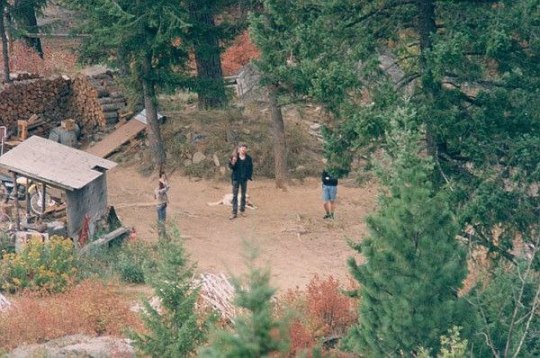
On August 21st, 1992, six Deputy US Marshalls entered the property to provide ground level reconnaissance and choose a spot to ambush and arrest Weaver. Deputy Marshall Art Roderick threw rocks at the cabin to see how the dogs would react. The cabin was at this time out of meat and, thinking the dog’s reaction may have been provoked by a game animal, Randy, a friend named Kevin Harris and Weaver’s 14-year-old son Samuel came out with rifles, to investigate. Vicki, Rachel, Sarah and baby Elisheba, remained in the cabin. 👇
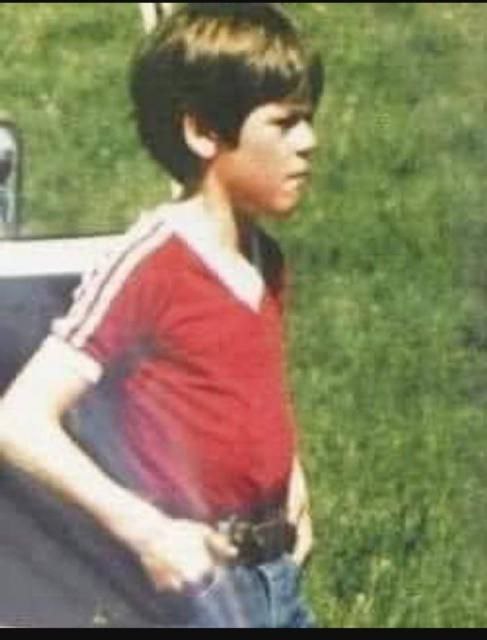
When Striker discovered the team's locations, on of the Marshalls shot and killed the dog. This caused a brief firefight. By the time the shooting stopped, Deputy US Marshall William Degan had been shot and killed by Harris. Tragically, 14 year old Sammy was also dead, shot in the back by the Marshalls while trying to help his dog. 👇

The situation quickly spiraled. The National Guard was called in, as well as SWAT teams and helicopters. The Weavers moved Sammy's body into a small shed near the main house, then retreated into the house. 👇
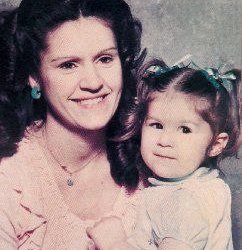
The next day, August 22nd, Weaver and his 16 year old daughter Sarah, along with Harris, left the main house to enter the shed Sammy's body lay. FBI sniper Lon Horiuchi fired from a position some 200 yards distant. The bullet tore into Weaver’s back and out his armpit. The three raced back to the cabin. Horiuchi’s second round entered the door as Harris dove for the opening, injuring him in the chest before striking Vicki in the face as she held baby Elisheba, in her arms. Vicki did not survive. 👇
Two days later, FBI Deputy Assistant Director Danny Coulson wrote the following memorandum, unaware that Vicki Weaver lay dead:
“Something to Consider
1. Charge against Weaver is Bull Shit.
2. No one saw Weaver do any shooting.
3. Vicki has no charges against her.
4. Weaver’s defense. He ran down the hill to see what dog was barking at. Some guys in camys shot his dog. Started shooting at him. Killed his son. Harris did the shooting [of Degan]. He [Weaver] is in pretty strong legal position.” 👇
The siege of Ruby Ridge would drag on for ten days. Kevin Harris was brought out on a stretcher on August 30, along with Vicki’s body. Randy Weaver emerged the following day. Subsequent trials acquitted Harris of all wrongdoing and Weaver of all but his failure to appear in court, for which he received four months and a $10,000 fine. 👇
In August 1995, the US government avoided trial on a civil lawsuit filed by the Weavers by awarding the three surviving daughters $1,000,000 each, and Randy Weaver $100,000 over the deaths of Sammy and Vicki Weaver. Randy would pass away on May 11, 2022, after a long illness.
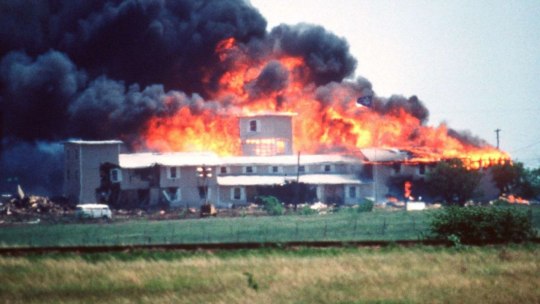
The atrocity at Ruby Ridge would not be the end of the story. Six months later, many of the same agents would be involved at the siege of the Branch Davidian compound in Waco, Texas.
The story of the Weaver family and Ruby Ridge reminds us all that just wanting to be left alone is often not an option. The Federal government, in particular the FBI, ATF, and US Marshalls, used deception, outright lies, and terroristic tactics, all in an attempt to entrap a man who refused to become an informant against his neighbors. 👇
History is not what we were told. Everything is a fμ¢%in' lie. 🤔
Posted August 21, 2024
#pay attention#educate yourselves#educate yourself#knowledge is power#reeducate yourself#reeducate yourselves#think about it#think for yourselves#think for yourself#do your homework#do your research#do your own research#do some research#ask yourself questions#question everything#ruby ridge#history lesson#hidden history#history#lies exposed
513 notes
·
View notes
Text

"It was a weird bacchanalian scene, with Janice dancing in wild abandon. . ."
Virgil Finlay (1914–1971) - Illustration for Alexander Blade's 'The Silver Medusa'
(Fantastic Adventures Vol.10 #2, February 1948)
#virgil finlay#the silver medusa#alexander blake#fantastic adventures magazine#horror art#fantasy art#pulp art#medusa#gorgon#illustration#story illustration
422 notes
·
View notes
Text
John Lennon and Yoko Ono: his affairs, binges and diet pills
For years the radio host Elliot Mintz was the only person the former Beatle and his wife trusted. Now, he has written a book about his intense relationship with the couple — including what really happened during Lennon’s infamous ‘Lost Weekend’
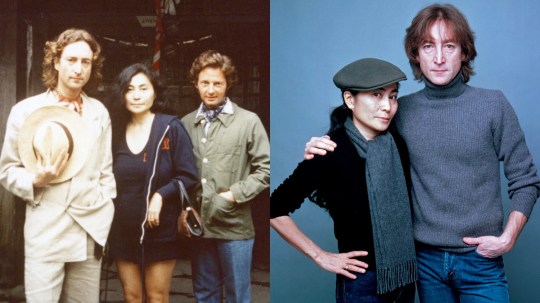
John Lennon, Yoko Ono and Elliot Mintz outside the Mampei Hotel in Karuizawa, Japan, 1977. Right: Lennon and Ono in 1980
I am holding a pair of glasses. They are antique, made of steel wire and perfectly round. The trademarked name is the Panto 45. This is the 26th pair of John’s glasses I’ve examined on this snowy night in February 1981. It’s been about two months since he was gunned down in New York outside the Dakota, the gothic edifice where he and Yoko Ono had been living since 1973.
I’ve been tasked with the responsibility of inventorying his personal effects so that Yoko, and posterity, would know precisely what he had left behind. I did not want this task. For one thing, I live 2,500 miles from the Dakota, in Los Angeles, where I host a late-night radio interview show. But Yoko asked me to do it, and I have rarely been able to say no to Yoko, let alone John.
I found their idealism infectious and inspiring. Still, as I got to know John and Yoko as flesh-and-blood friends, I began to see their flawed human sides as well.

The trio at a restaurant in Kyoto, 1977
Yoko, for one, was even more airy and ethereal in private than she was in the media. She could be a fountain of aphorisms, dispensing endless nuggets of Zen-like philosophy. Her haiku-esque homilies on manifesting one’s desires or the wisdom of the nonrational mind could be a bit much for some people.
There were moments when even I was a bit baffled by it all. Except then she would say or do something that would absolutely convince me that she was connected to some higher plane.
John, meanwhile, was every bit as charming, funny and intelligent as he came across in public. But I gradually discovered he was far from perfect. For starters, for a guy who aspired to be a world-shaking peacemaker — a thought leader on a par with Mahatma Gandhi, Martin Luther King Jr and Nelson Mandela — he was surprisingly uninformed about historic figures like, well, Gandhi, King and Mandela.
He also had some Luddite-like notions about science, particularly medicine, extending well beyond his annoyance at “daddy doctors” for not letting him perform his own weight-loss injections. Even though John had smoked, ingested or snorted just about every illegal recreational drug he could get his hands on, he was weirdly suspicious of the ones that were properly prescribed and proven efficacious.
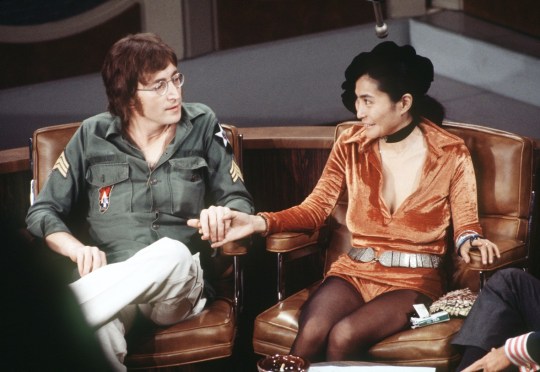
Lennon and Ono on The Dick Cavett Show, 1971
John and Yoko could be incredibly sensitive, honest, provocative, caring, creative, generous and wise. They could also be self-centred, desperate, vain, petty and annoying. In John’s case, also shockingly cruel — even to Yoko.
An example…
Early one morning in November 1972, the red ceiling light that would flash whenever my hotline to John and Yoko rang started blinking. I picked up.
“Ellie, I f***ed up,” were the first words out of John’s mouth.
“Why?” I groggily asked. “What did you do?”
“We were at this party last night,” he said, “and I got loaded. And there was a girl…”
I sat up in bed.
The party was at Jerry Rubin’s Greenwich Village apartment. A small crowd of well-connected peaceniks had gathered to watch the presidential election returns on television. As it became clear that Richard Nixon would win re-election by a landslide, the mood grew bleaker and the crowd began drinking more heavily.
Alcohol was not John’s friend and on this occasion, John’s evil inner gremlins truly outdid themselves.
I got some of the specifics from a hungover John during his morning-after call. The upshot was that John had indeed hit it off with some girl at the party and had slipped into a bedroom with her, where they proceeded to have such loud, raucous sex that everyone sitting around the TV in Rubin’s living room — including Yoko — could clearly hear them going at it.

Lennon and Mintz in 1972
At one point, a well-meaning guest put a record on the turntable — Bob Dylan’s 11-minute ballad Sad Eyed Lady of the Lowlands — at high volume. Yoko sat on the sofa in stunned, mortified silence.
Whatever they said to each other later, I suspect the conversation was not a pleasant one.
“I slept on the sofa,” John told me, sounding defeated and embarrassed — although, frankly, not quite as contrite as I thought his situation warranted. “Things like that happen,” he said, way too matter-of-factly for my taste. “A bloke cheats on his wife… If I weren’t famous, nobody would care.”
Yoko, unsurprisingly, felt differently.
“Are you OK?” I gently asked her when I phoned to check in on her a few hours later.
“There is no answer to that question,” she said shakily.
“Do you think you’ll ever be able to forgive him?”
“I can forgive him,” she said. “But I don’t know if I can ever forget what happened. I don’t know if it will ever be the same.”
After a few weeks of cooling down, though — during which Yoko wrote and recorded Death of Samantha, her bluesy ode to burying one’s pain for the sake of outward appearances — the crisis seemed to abate. John and Yoko chose to roll the cosmic dice with a spectacular gesture of faith and hope in the staying power of their love. They bought an apartment in the Dakota.
“It’s apartment No 72,” Yoko announced when she called to tell me about the purchase. ���Do you see the significance?”
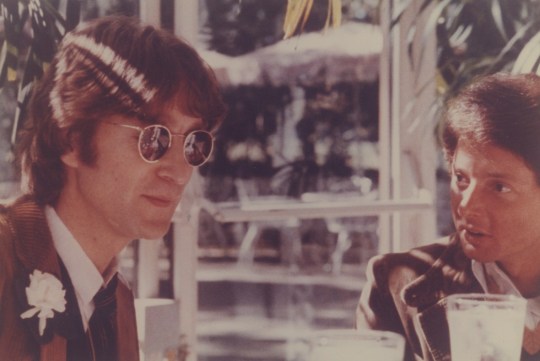
Lennon’s 38th birthday party, 1978
When you add seven and two, you get nine, Yoko explained, which was a hugely significant numeral to the Lennons, a magic integer that seemed to mysteriously recur throughout John’s life. Yoko would rattle off the number’s many repeated appearances: John was born on October 9. She was born on February 18 (1 plus 8). Paul McCartney’s last name has nine letters…
I was somewhat mystified as to why they chose this particular neighbourhood. “Aren’t you worried it’ll be too stuffy for you?” I asked John. “Will the people who live there even know who you are?”
“I don’t want them to know who we are,” he said with a laugh. “I don’t want to know who they are. We just want to be left alone.”
The Dakota struck me as one of the most eerily beautiful — and oddly daunting — structures in all of New York. John and Yoko greeted me in the vaulted vestibule, eager to begin our tour, which started on the ground floor with the new headquarters for Studio One, the business entity behind John and Yoko’s creative enterprises. Tellingly, John did not have an office in Studio One; Yoko did.
The main attraction was on the seventh floor. It was nearly 5,000sq ft, with massive windows offering eye-popping views of Central Park. Virtually everything in its expansive living room, from the plush carpeting to the grand Steinway piano, was as white as Japanese snowbells.

Lennon, Ono and Mintz at a Shinto temple in Kyoto. The custom was to hang your horoscope on a line
There was only one highly conspicuous work of art in the White Room: a Plexiglass case on a white pedestal, in which was a 3,000-year-old sarcophagus. John and Yoko had scored the very last mummy allowed out of Egypt before the Egyptian government put a ban on exporting their national antiquities.
“You should x-ray it and see what’s inside,” I suggested. “There might be something of great value, like precious jewels.”
“I don’t care what’s inside,” Yoko responded. “The great value is the magic of the mummy itself.”
Another thing I clearly remember about that long afternoon at the Dakota was how enthusiastic both John and Yoko seemed about the life they were building together in this new nest. John giddily described the “entertainment centre” he wanted to construct in a nook off the kitchen. Yoko, ever the artist, chattered about the endless design ideas she had. It was all too easy to forget about the pain and stress they’d been dealing with. I managed to convince myself that the worst was over for John and Yoko. I was wrong.
There are those who believe Yoko not only approved of the affair but arranged it. That she planted May Pang in the seat next to John on that American Airlines flight from New York to Los Angeles knowing full well what was likely to happen. That their comely 23-year-old assistant would sooner or later end up sleeping with her husband.
It’s possible, I suppose. It could be she saw some strategic long-term advantage in setting up the affair; by handpicking John’s mistress, she might have felt she could exert some dominion over his extramarital wanderings. Perhaps, thanks to her mystical advisers, she really did see that John was heading for a free fall and was endeavouring to soften his inevitable crash.
If any of that is true, though, Yoko never breathed a word of it to me. All she said in October 1973 was that she was sending John and an assistant to LA. Could I please meet them at the airport?

With his assistant and lover, May Pang, 1974
I was by then aware that their marriage was in deep trouble. Despite their best efforts to mend the relationship, the red light on my bedroom ceiling had been blinking even more feverishly than usual leading up to what would later be known as John’s “Lost Weekend”, the 18 months he spent in exile from his wife in New York.
Yoko’s demeanour back then, as always, was not demonstrably emotional but it was clear from our phone conversations that she was in pain. John’s calls were every bit as depressing.
“Has Mother been talking to you about us?” he asked during one early morning chat.
“Yoko talks to me about everything,” I answered vaguely.
“The other day I shaved and got dressed up and told her I wanted to take her to her favourite restaurant and she turned me down,” he lamented. “She said she didn’t have time. Me own f***ing wife said that to me!”
Yoko has always been a methodical person, and my guess is that she precisely and carefully orchestrated John’s eviction from the Dakota. John might not have even realised what was happening to him. He certainly didn’t seem like a man who’d been kicked out of his home when I met him and May Pang at LA airport.
“You look trim, Ellie,” he said with a big grin when I greeted them. “Have you been taking those diet pills again?”
They had very little luggage, suggesting that neither of them was expecting a long stay. My instructions from Yoko were to drive them to music manager Lou Adler’s house in Bel Air, a mini-mansion up on Stone Canyon Road.
“I need some money,” John said as we settled into my weary old Jaguar. “Mother said these could be used for money,” John continued, shoving a fistful of traveller’s cheques in my hand.

The couple outside the Dakota building in New York, 1980. They bought an apartment there in 1973
John was functionally a child when it came to taking care of himself. But then, that was what May was for. Whatever other intentions Yoko may or may not have had for the assistant, her primary job was to make sure John was properly fed and cared for, that all his basic needs — or at least most of them — were satisfied.
John and I spent a lot of time together over the next several weeks. He was also expanding his friendship circle in LA, hanging out with people like Harry Nilsson, the brilliant but notoriously hell-raising singer-songwriter. But after three or four months, much of his initial enthusiasm had boiled off and his mood was starting to curdle. He was missing Yoko: he began asking me when I thought she’d be ready for him to come home. He started spending more and more time with Nilsson, drinking at the Troubadour till all hours. After John famously got thrown out for drunkenly heckling the Smothers Brothers, the late-night shenanigans moved to the Rainbow Bar & Grill on Sunset. That’s where John and Harry and a collection of others — including my old pals Micky Dolenz and Alice Cooper — formed an infamous drinking club known as the Hollywood Vampires.
It would be difficult to exaggerate the level of unbridled indulgences that took place in the Rainbow’s VIP room, a small alcove atop some stairs overlooking the bar. The amount of alcohol imbibed was staggering, to say the least, and there were also small bags of cocaine discreetly passed into the room. Nilsson, a great big bear of a man, could pound down a dozen or so brandy alexanders — a potent mix of brandy and cream, his cocktail of choice, which John soon adopted as his own — in a single sitting.
Not being a celebrity, I was never invited to become a member of the Hollywood Vampires, but I was a welcome visitor and spent many a late night on the edges of their wild, sometimes harrowing saturnalias.
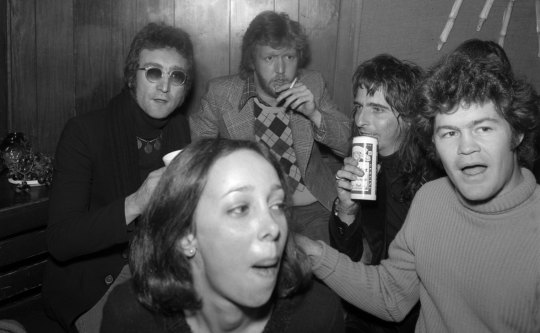
Lennon with his Hollywood Vampires drinking partners, from left, Harry Nilsson, Alice Cooper and Micky Dolenz, November 1973
There was always a crowd of attractive young women at the bottom of the steps leading to the Vampires’ VIP lair. Frankly, though, by the time the boys descended, usually at closing time, most of them were too wasted to take advantage of the opportunity. I lost count of the number of times I all but carried John down those stairs and poured him into whatever car service I had called to the bar’s car park.
For the most part, I kept my promise to Yoko: I kept John safe. But one night, I realised things were starting to spiral out of my control. Normally, John didn’t put up much of a fight when I helped him down the stairs at the Rainbow Bar but on this occasion, he resisted. He didn’t want to go home.
He pushed away and dived straight into the crowd. It was my worst nightmare: a drunken star lost inside a drunken mob.
Finally, I spotted John with Nilsson at the edge of the car park, the two of them climbing into the back of a black limousine. A moment later, it pulled away into the night, going I had no idea where.
John, I realised with a sinking feeling in my gut, was slipping away.
I was about to walk into the nadir of the Lost Weekend, John’s rock bottom. The call came not on the hotline but my regular house phone, and the voice on the other end identified himself as a security officer working for Phil Spector. John was in trouble: could I please hurry over to Adler’s house and help “calm him down”.
What I saw when I stepped into Adler’s living room some 20 minutes later looked like a scene out of The Exorcist. Drunk and wild-eyed, John was strapped to a high-backed chair, his arms and legs restrained with ropes, which he was struggling against with all his might as he shouted obscenities at his captors, a pair of beefy-armed bodyguards who stood in awkward silence nearby. The place was a shambles. John had torn some of Adler’s framed gold records off the walls and smashed them to pieces. Bits of broken wood and shattered Plexiglass littered the floor.
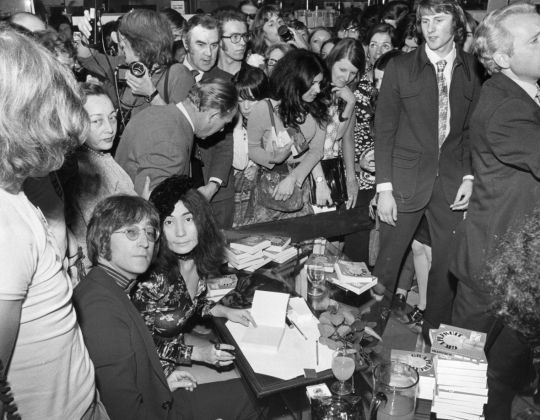
The couple in Selfridges in London where Ono was signing copies of her book Grapefruit, July 1971
Apparently, the meltdown had started earlier that evening at the studio, where John and Phil had nearly come to blows. What precisely they were arguing about, nobody seemed to remember. But the session ended early with Phil’s guards restraining John and shuttling him to Adler’s house, where John slipped away from them long enough to pick up some sort of walking stick or cane, which he swung wildly around the living room until the guards were able to subdue him.
I slowly stepped up to John, who had stopped shouting. His head hung low on his shoulders, his chest heaving furiously. After a long beat, he slowly lifted his eyes to me. He looked possessed.
“Get these ropes off me!” he erupted. “Get them off me, you…”
And then John spat out an epithet so hurtful and offensive, I can’t bring myself to repeat it.
I looked straight into his eyes, barely containing my disgust and disappointment. He looked back into mine. And that exchange of glances seemed to reach some shred of humanity buried deep in John’s alcohol-addled brain. Suddenly he became very, very quiet.
After a moment or two, I turned to the guards. “I think you can take those ropes off him,” I said. “I think he’s done.”
John stood up, rubbed his wrists and, without another word, slowly made his way down the hall to the bedroom, where he must have collapsed on the mattress and passed out.
The next day, as I was getting ready to leave for work, the hotline started flashing.
“Ellie?” John said. “I’m sorry for what I said. But if you think about it, if that’s the worst thing I could say about you, you couldn’t be all that bad, right?”
“Thanks for the compliment,” I said.
“Well, welcome to the real world, Mother Virgin Mary. I’m me. I have a big mouth and express meself the way I feel when I feel it. I don’t hide behind some microphone. I sing into it or speak into it when it suits me. I’m not always the Imagine guy or the Jealous Guy or the Walrus. So I said I’m sorry to you. That’s all I can do.
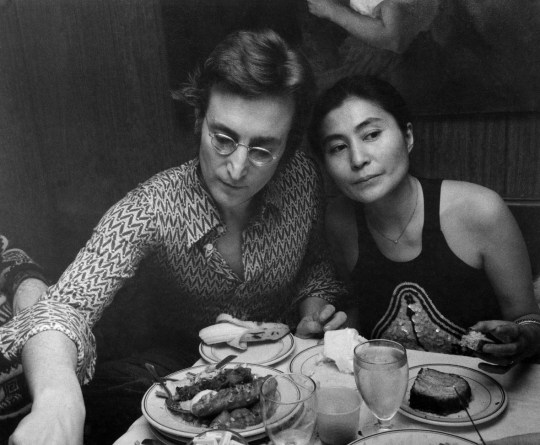
Lennon and Ono in 1972
“Do you want to have dinner?”
“No,” I answered. “I think I’m going to take the night off.”
For the first time I can remember, I was the one who hung up the phone.
Obviously, our friendship took a hit after the incident at Adler’s house; how could it not? For the next several months, John and I barely spent time together — at least, not in person. We would talk almost every day on the phone, as we always had, and eventually our rapport began to feel as easy and familiar as ever. But I no longer joined him for evenings at the Troubadour or the Rainbow.
John, meanwhile, had shifted from the mayhem of the Spector sessions to the slightly lesser bedlam of producing a record for his pal Harry Nilsson. The most notable thing about the Pussy Cats sessions was who else was in the room. Ringo Starr sat in on drums. And although it never made it onto Nilsson’s album, another ex-Beatle unexpectedly turned up and even sang with John, the first time the two of them had performed together since the Beatles split.
I wasn’t present but later heard that Paul McCartney and his wife, Linda, had popped in without warning, bringing Stevie Wonder with them. According to those who were there, John and Paul seemed to pick up their friendship as if they were teenagers again, but when John told me about it later, he was kind of dismissive about it, saying, “They were all just looking at us, thinking that something big was going to happen. To me, it was just playing with Paul.”

Lennon with Harry Nilsson, left, outside the Troubadour club in West Hollywood, having just been ejected for heckling a performance by the Smothers Brothers, March 12, 1974
What John didn’t know, though, was that, according to Yoko, Paul had an ulterior motive for the visit. A few days earlier, she had called me to explain the machinations behind the visit.
Yoko told me she spoke with Paul, who offered to speak with John. “I thought it was very kind,” she said. “I was very appreciative. But I made it very clear to Paul that it wasn’t something I was asking him to do. It would have to be Paul’s idea, not mine.”
To me, there was never any question that John desperately wanted to get back with Yoko. Yes, he had feelings for May, yet at some point during virtually every phone call I had with him, John would sooner or later beseech me to talk to Yoko on his behalf. “Tell Mother I’m ready to come home, Ellie. Tell her I’m a changed man.”
“I don’t think she wants to hear it from me,” I would say. “She wants you to show it to her.”
Paul, I later heard, gave John similar advice. Sometime after popping into the studio in Burbank, he sat down with John and laid out, step by step, what he would need to do to win Yoko back.
It’s impossible to say if Paul’s presentation was what did it, or if John experienced some other epiphany around that time, but over the ensuing months he did indeed begin to clean up his act. In the summer of 1974, he started working on his next album, Walls and Bridges, regularly flying to New York for rehearsals and recordings at the Record Plant on West 44th Street. By all accounts, those sessions were entirely professional, with John showing up 100 per cent sober every day.
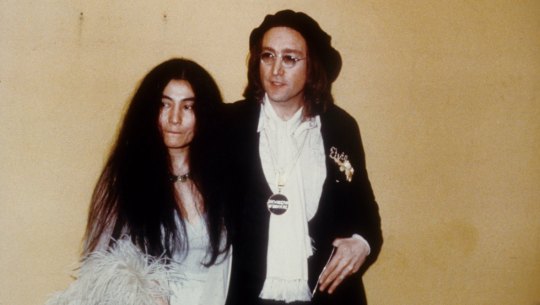
At the Grammy Awards in New York, March 1, 1975
Then, as work on the album neared completion, John made a fateful decision: he decided not to wait any longer for Yoko’s invitation to return to New York. Instead, towards the end of the summer, he and May rented an apartment of their own on the Upper East Side. It was a small but comfortable place that had a wraparound balcony with spectacular views of the East River.
When I flew to New York to tape some interviews, I took the opportunity to pay them a visit — my first face-to-face meeting with John since the ugliness at Adler’s house. It was an awkward encounter for numerous reasons. For one thing, I had just spent an afternoon with Yoko at the Dakota, some 20 blocks away; taking a cab across town to John and May’s felt something akin to betrayal.
Perhaps sensing my apprehension, May gave me a wide berth, leaving to make some phone calls in a bedroom while John and I stood together on the balcony, catching up.
“Does this make you feel uneasy?” John asked after a beat.
“You mean being here with you and May? Yes, a little,” I admitted. “It just reminds me of the fact that you and Mother are still separated, and that makes me sad.”
“Well, that’s the way Mother wants it,” he said. “At least for now.”
Then, unexpectedly, he wrapped his arm over my shoulders and added, “Don’t look so glum, me boy. Put on your radio face. There’s nowhere you can be that isn’t where you’re meant to be.”
It was one of the few times he’d quoted a line to me from a Beatles song.
Walls and Bridges was released a month or so later. John sent a prereleased signed copy (“To my little dream lover on ice, with love and old pianos,” he wrote, referring to my affection for Bobby Darin’s hit song).
As it happened, Elton John had joined John on keyboards for one song on the album. Elton made a bet with John. If the song was a hit, John would have to perform at Elton’s upcoming concert at Madison Square Garden. John agreed, never imagining he’d have to honour that promise.
Of course, Elton was spot on: Whatever Gets You Thru the Night did indeed become John’s first No 1 solo single. And so it came to pass that, in November 1974, onstage at Madison Square Garden, in front of thousands and thousands of fans, that the Lost Weekend finally began to fade to a finish.
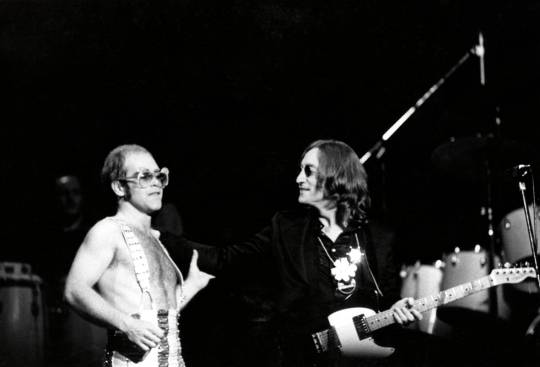
Lennon’s surprise appearance at Elton John’s concert at Madison Square Garden, November 28, 1974
The details of what exactly transpired backstage that night remain, 50 years later, shrouded in some mystery. What is known is that Yoko, who’d been invited to the concert by Elton’s manager, was in the audience. She couldn’t have been prepared for the reaction around her when Elton announced, about two thirds into the concert, that he was bringing John onto the stage for his first public performance in two years. The crowd went berserk.
After the show, Elton’s manager approached Yoko and told her that Elton had requested her presence in his dressing room. Yoko was led backstage to a door with a star on it. She knocked, the entrance opened, and inside she saw her husband standing there, alone.
I cannot tell you what happened after the dressing room door closed behind them. Nobody but Yoko knows that, and she has never shared with me any details. What I can tell you is that in the weeks and months that followed, there must have been many more rendezvous as Yoko and John re-established their connection, even as he continued living with May in their East Side apartment.
According to one of May’s early accounts, John was ultimately hypnotised into ending his relationship with her; she has long claimed that Yoko hired a mesmerist to help John quit smoking but that it was all a ruse to brainwash him into splitting up with her so he could return to Yoko. To this day, many people believe that story. But I know for certain that it wasn’t true. Because, as it happens, I’m the one who arranged the hypnotist.
Yoko had nothing to do with it.
John had remembered that I had interviewed a hypnotist on my radio show and asked me if he might be able to help him kick nicotine.
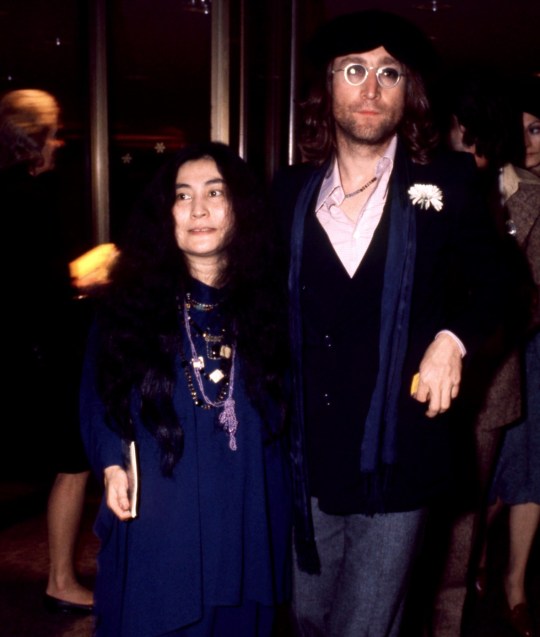
At the Lincoln Center in New York, circa 1975
I called the hypnotist, planned for him to fly to New York, booked him a room in a Midtown hotel, and set up an appointment with John. In just about every respect, though, the hypnosis was a total bust. John told me immediately afterwards he was never put under; the hypnotist claimed John was but just couldn’t remember. The hypnotist also turned out to be something of a diva. He disliked his hotel — he thought the desk clerks were rude — and checked out the next day, flying back to LA in a huff.
John didn’t quit smoking, not for a minute, so it’s hard to imagine the hypnotist had succeeded in brainwashing him into anything else — like, say, leaving a lover. But the very next day, John did break it off with May and returned to the Dakota, resuming his marriage to Yoko and ending, at last, the long and lonely winter that had been the Lost Weekend. He called me in LA shortly afterwards to share the happy news.
He said, “Let the media know the separation did not work.”
‘He’d weigh himself twice a day’
Elliot Mintz on his friendship with John and Yoko. By Georgina Roberts
When a red light in Elliot Mintz’s bedroom flashed, it meant that John Lennon or Yoko Ono was calling him on a special hotline. “In an average week, 20 hours of phone conversation would not be unusual,” the 79-year-old former radio DJ and talk-show host says from his Beverly Hills living room.
Mintz describes the friendship with the couple that “dominated” nine years of his life as “almost a kind of marriage”. He was taken aback when Ono called him in 1971 to thank him for not asking about Lennon when he interviewed her on his radio show. When they began to speak for hours at night, she batted away his concern that her husband might get jealous, saying, “Aren’t you giving yourself a little too much credit, Elliot?”
Lennon first called Mintz to ask if he could get him fat-melting pills. “That was my first conversation with John Lennon. It wasn’t philosophical. It wasn’t about Elvis or the Beatles. It was about weight loss,” he says. Sometimes Lennon would weigh himself twice a day and the couple “were obsessive about diet”.
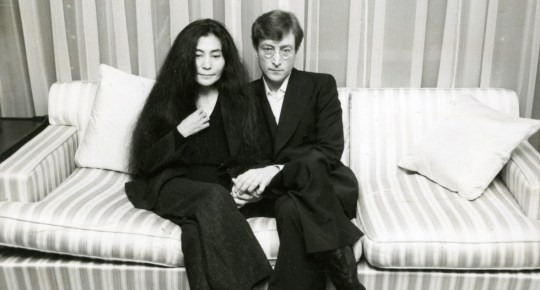
In Hotel Okura in Tokyo, October 1975
After six months of speaking, the couple summoned him to meet them in Ojai, California, where they were trying to kick a methadone addiction. Ono barely spoke until she was in a bathroom with the tap running. “She whispered to me, ‘This house is bugged. Everything we say here, they’re listening. So you have to be very careful what you say.’ ” FBI files released years later showed that Ono wasn’t being paranoid. President Nixon had placed the couple under surveillance after rumours they planned to disrupt his convention, Mintz says.
His clandestine friendship with the couple wreaked havoc on his love life. When he couldn’t explain whom he’d been speaking to in the middle of the night, one love interest assumed he was married and stormed out. “I realised at that moment that my love life would have to take a back seat to my relationship with John and Yoko,” he says.
There were times when lines were crossed in the friendship. One morning, Lennon summoned Mintz to kick out a girl who’d stayed the night. “I told him, ‘Please don’t ask me to do something like that again.’ He flipped out. He said, ‘I will effing ask you to do anything that I feel like asking you to do. Do you understand that?’ ” Mintz was hurt and offended. The next day was one of the few times he said no to “grabbing a bite” with Lennon.
Becoming parents was “the biggest game-changer” for the couple. After his son Sean was delivered via caesarean section in 1975, “John was outraged that when Yoko was clearly struggling, doctors would come up to him and say, ‘I’ve always dreamt of shaking your hand.’ He would bark at them, ‘Look after me wife!’ ”
While Lennon threw himself into childcare, Ono, who came from a banking dynasty, handled the couple’s finances. After becoming stratospherically famous so young, Lennon was “clueless” about money. “I doubt if John was ever in a supermarket, went to a bank, wrote a cheque. That’s what Yoko did,” Mintz says. “If not for Yoko, there’d be no money in the Lennon-Ono estate today.”
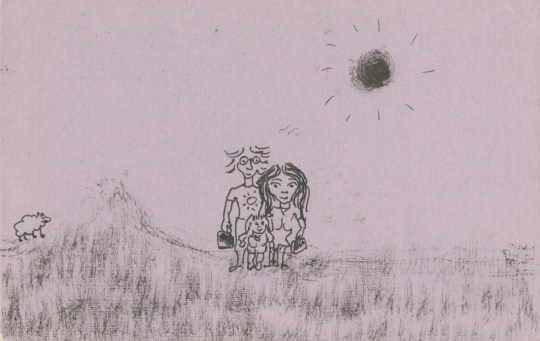
A drawing by Lennon on a postcard from Japan sent to Mintz in 1977
The first time Mintz met their son, Lennon said protectively, “Not too close. Germs.” “He said, ‘Look, we were going to make you the godfather, but we decided on Elton, because he would at least give him better Christmas presents.’ ” “This is typical John,” Mintz says.
Sean would only spend five years with his father before Lennon was murdered outside the Dakota in December 1980. Lennon had always “poo-pooed” Mintz’s requests for him to employ more security. “John said, ‘I’m just a rock’n’roll singer. Who would want to hurt me?’ ”
When Mintz speaks about learning of Lennon’s murder from a weeping flight attendant, his honeyed radio-presenter voice cracks with emotion. “Even now, after all these years, just thinking about that moment…” He trails off. The most gut-wrenching of his responsibilities was making an inventory of Lennon’s possessions. When he signed for a stapled brown paper bag that came from the hospital where Lennon was taken after he was shot, he could not bear to open it. “It was what John was wearing, what he had on him when he fell, including his broken, bloodied glasses.”
He is reticent about his friendship with Ono today. “I want to give her a sense of privacy,” he says, but adds, “It still feels like family. I still love her dearly.” The last time he saw her was at her 91st birthday in February. It was there that Sean encouraged Mintz to write his book, We All Shine On. Does he think Ono will like it? “I’ve never tried to predict a Yoko Ono conclusion.”
How different would his life be if he had never met the couple? “I could have got married. Could have had children.” Were the sacrifices worth it? “Of course. I got to spend that amount of my time with these two extraordinary people.”
We All Shine On: John, Yoko, & Me by Elliot Mintz (Bantam, £25).
(source)
338 notes
·
View notes
Text
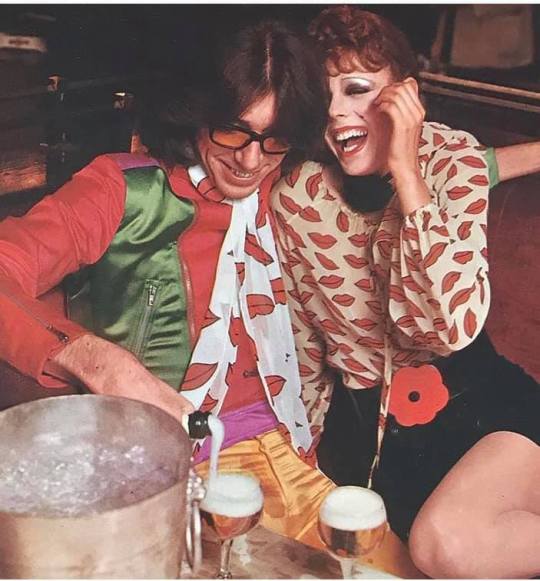
Vogue Italia February 1971
Wallis Franken wears a printed ivory crepe blouse with vermilion red lips. The blouse is gathered at the neckline and cuffs. The shorts, black, are made of velvet, without cuffs. At the waist is a patent black belt with a large red flower. He is wearing a jockey top from the Rive Gauche Homme collection in red, green and purple satin and pants in chrome yellow satin. Hair: Jean-Marc Maniatis Makeup: Gil de Max Factor.
Wallis Franken porte une blouse en crêpe ivoire imprimée, de lèvres rouge vermillon. La blouse est froncée à l'encolure et aux poignets Le short, noir, est en velours, sans revers. A la taille se trouve une ceinture noire vernie avec une grande fleur rouge. Lui porte un haut jockey de la collection Rive Gauche Homme en satin rouge, vert, violet et un pantalon en satin jaune chrome. Coiffure : Jean-Marc Maniatis Maquillage : Gil de Max Factor.
Photo Chris von Wangenheim Vogue Italia Archivio
#vogue italia#february 1971#ready to wear#prêt à porter#yves saint laurent rive gauche#ysl#wallis franken#chris von wangenheim#max factor#jena-marc maniatis#vintage vogue#vintage fashion
5 notes
·
View notes
Text


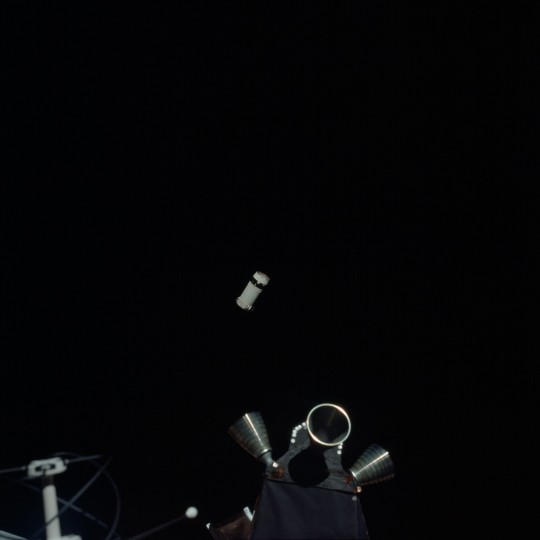

View of the Lunar Module Antares (LM-8) in the S-IVB of Apollo 14 before and after it was retrieved.
Date: February 1, 1971
NARA: 16699729
NASA ID: AS14-72-9920, AS14-72-9924, AS14-72-9928, AS14-72-9931
#Apollo 14#CSM-110#Kitty Hawk#LM-8#Antares#Lunar Module#NASA#Apollo Program#H-type mission#S-IVB#February#1971#space#my post
50 notes
·
View notes
Text

Glamour magazine, February 1971
676 notes
·
View notes




